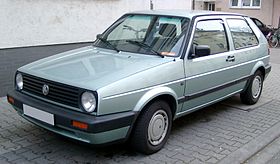
Back فولكس فاغن غولف 2 Arabic Volkswagen Golf II Danish VW Golf II German Volkswagen Golf II Spanish فولکسواگن گلف امکا۲ FA Volkswagen Golf II Finnish Volkswagen Golf II French Volkswagen Golf Mk2 ID Volkswagen Golf II Italian Volkswagen Golf II Polish
| Volkswagen Golf Mk2 (19E) | |
|---|---|
 | |
| Overview | |
| Manufacturer | Volkswagen |
| Production | September 1983–1992 1985–1992 (Yugoslavia) 6.3 million units[1] |
| Assembly |
|
| Designer | Herbert Schäfer |
| Body and chassis | |
| Class | Small family car (C) |
| Body style | 3-door hatchback, 5-door hatchback |
| Layout | Front engine, front-wheel drive / four-wheel drive |
| Platform | Volkswagen Group A2 platform |
| Related | |
| Powertrain | |
| Engine | |
| Transmission | 4-speed manual 5-speed manual 3-speed automatic |
| Dimensions | |
| Wheelbase | 2,470 mm (97.2 in) |
| Length | 3,985 mm (156.9 in)−4,054 mm (159.6 in) |
| Width | 1,665–1,700 mm (65.6–66.9 in) |
| Height | 1,415 mm (55.7 in) |
| Curb weight | 725–1,245 kilograms (1,598–2,745 lb) |
| Chronology | |
| Predecessor | Volkswagen Golf Mk1 |
| Successor | Volkswagen Golf Mk3 |
The Volkswagen Golf Mk2 is a hatchback, the second generation of the Volkswagen Golf and the successor to the Volkswagen Golf Mk1. It was Volkswagen's highest volume seller from 1983 and ended in (German) production in late 1992, to be replaced by the Volkswagen Golf Mk3. The Mk2 was larger than the Mk1; its wheelbase grew slightly (+ 75 mm (3.0 in)), as did exterior dimensions (length + 180 mm (7.1 in), width + 55 mm (2.2 in), height + 5 mm (0.2 in)). Weight was up accordingly by about 120 kg (260 lb). Exterior design, developed in-house by VW design director Schäfer, kept the general lines of its Giugiaro-designed predecessor, but was slightly more rounded. All told, about 6.3 million[2] second-generation Golfs were built.
- ^ Bangemann, Christian; Jeske, Beate (2008). "Volkswagen Golf II". Auto Motor und Sport. No. 18. Stuttgart. p. 24.
- ^ Deutsche Autos, Band 5, 2001, p. 250.